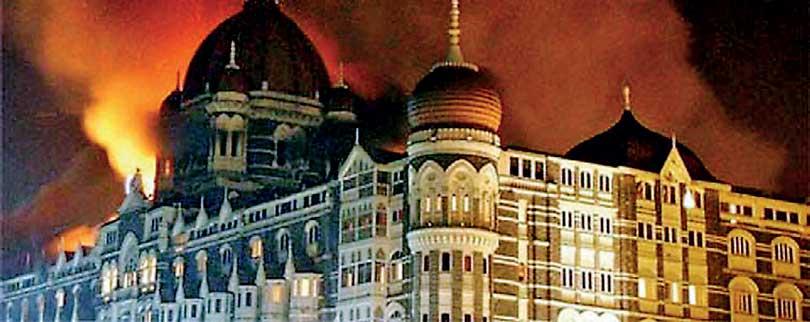28 Nov 2023 - {{hitsCtrl.values.hits}}

The Taj Mahal Hotel, Mumbai: The devastating sea-borne terrorist attack on Mumbai on November 26, 2008
 In a paper on the devastating sea-borne terrorist attack on Mumbai on November 26, 2008, in which 179 people, including 29 foreigners, were killed, the RAND Corporation observed that India and other littoral States of the Indian Ocean have failed to fully grasp the importance and intricacies of coastal security.
In a paper on the devastating sea-borne terrorist attack on Mumbai on November 26, 2008, in which 179 people, including 29 foreigners, were killed, the RAND Corporation observed that India and other littoral States of the Indian Ocean have failed to fully grasp the importance and intricacies of coastal security.
Abhijit Singh of the New Delhi-based Observer Research Foundation (ORF) who had written in 2017 and 2023 about the state of coastal security in India, appreciates the improvements made since “26/11” but he also points out the gaps and loopholes. His overall verdict is that even 15 years after 26/11 India’s coastal security is
“sub-optimal.”
Another interesting observation he makes is that States tend to go for costlier Blue Water navies in preference to Coast Guards. “The Indian Navy tends to view big-ticket initiatives as the building blocks of the security architecture,” Singh notes. Mighty Blue Water navies enjoy national and international prestige and geopolitical relevance, which Coast Guards do not.
Sadly, this is so despite increasing threats from small boats disguised as fishing vessels that are used by criminals indulging in smuggling, drug running, human trafficking, and ferrying terrorists. Illegal and unauthorized fishing are another major problem.
Northern Sri Lanka faces the problem of poachers from Tamil Nadu with no solution in sight.
In its paper on the 26/11 attack, RAND Corporation says that the Indian authorities had unspecific intelligence about the coming of a terror squad from Karachi in Pakistan to the Mumbai coast by boat, but it was either not conveyed to the local police or the local police did not act upon the intelligence.
However, after the 26/11 mayhem, India improved its coastal security by forming new and specialized agencies that were expected to work in a coordinated manner.
The task was onerous as India has a 7517 km Indian coastline (including the islands of Andamans, Nicobar and
Lakshadweep islands).
The Indian Central government set up a three-tier security arrangement comprising the Indian Navy (IN), the Indian Coast Guard (ICG) and the State Marine Police.
Coastal Police stations and a surveillance infrastructure under a Coastal Security Scheme (CSS) were set up. Radar stations came up along the coastline. Automatic Identification Systems and Joint Operation Centres (JOCs) were established.
“Sagar Kavach” exercises, involving the Navy, ICG and the State coastal police, were held.
“And yet, 15 years after 26/11, the overall state of India’s coastal security remains suboptimal,” Abhijit Singh remarks.
To illustrate, he cites a case in April 2017 when a Russian couple on a sailing boat drifted close to the Mumbai harbour without being noticed by any security agency. They were spotted and reported to the police by fishermen. In another case in 2017, a foreign ship hit a fishing boat off Thiruvananthapuram in Kerala and escaped as no Indian vessel went in pursuit.
Again in 2017, a Comptroller and Auditor General’s report said that in Odisha State on the east coast, patrol boats were under-utilized and shore-based infrastructure, including manpower, showed shortages. Funds remained unspent.
Further, country-wide, there was a 90% shortfall in patrolling, especially at night. There was a decline in physical checks on fishing vessels by the Coastal Police.
In the coastal Police Stations, 75% of the sanctioned posts were unfilled.
RAND Corporation advocates the arming of security personnel in ports and other sensitive installations with modern weapons to match the terrorists’ arsenal.
There is an over-reliance on high-end technology and less on human intelligence collected by the State coastal police forces and fishermen, Singh points out.
He advocates a greater involvement of the local police and fishermen and urges the authorities to train, equip and motivate them. But there is a problem in engaging fishermen. They are reluctant to install any identification systems on their boats.
The States’ Marine Police display a lack of enthusiasm because State governments, barring Tamil Nadu’s, themselves give marine security
low priority.
Singh points out government reports show that in Andhra Pradesh, none of the coastal police stations had their own captive jetties. Though the port of Vishakhapatnam was allotted interceptor boats they were mostly non-operational.
And on top of it all, there were problems of coordination between the multiplicity of agencies involved in coastal security.
“Despite the best efforts of the National Committee for Strengthening Maritime and Coastal Security (NCSMCS), the coordination of coastal security is ad hoc,” Abhijit Singh observes. He refers to a recent Intelligence Bureau audit that said that the vast majority of minor ports in India have little or no security cover.
“Few out of the 227 minor ports in India have proper security cover. As many as 187 minor ports have minimal security cover and 75 no security cover at all,” Singh quotes the report as saying.
Sri Lankan Coastal Defence
Sri Lanka has a coastline of 1340 km. But it is lightly defended, partly due to the step-motherly treatment traditionally given to the navy and partly due to the loss of the island’s maritime tradition.
According to archaeologist Dr Raj Somadeva, in ancient times, Sri Lanka-built vessels were going back and forth between the island and Gujarat in Western India. But the country lost the sea-going spirit over time due to the advent of the Arabs and then the Portuguese, Dutch and British.
The decline of sea-faring in Sri Lanka enabled the European powers to penetrate the coasts unopposed. When pushed to a corner by intrepid local rulers, the European powers could get reinforcements from their other overseas posts because they had ships and navies.
The kingdoms of Kotte and Sitawaka were overrun by the Portuguese because the latter kept getting reinforcements from Goa and Cochin.
The local kings had no ships or navies to intercept the Portuguese at sea. At one stage, Kotte and Sitawaka could secure the help of the Zamorin of Calicut in Kerala who had a navy, but when the Moplah Muslim Admirals of the Zamorin’s navy were betrayed by the Sitawaka ruler, the Zamorin stopped sending his navy to help him. A Portuguese take-over thereafter was only a matter of time.
The lack of naval capability continued in later years. For decades after independence, Sri Lankan governments gave priority to land warfare, when the only threat was from the LTTE which was surviving and building up its arsenal because of its sea links with South India and other places in South East Asia.
It was only towards the end of the final Eelam War IV that the Navy got due importance. It was given Offshore Patrol Vessels (OPVs) and a large fleet of fast, light and suitably armed small boats. The OPVs given by India and intelligence inputs from the US helped the Lankan forces to annihilate the LTTE in May 2009.
Like the Navy, the Coast Guard (SLCG) also got step-motherly treatment. SLCG was founded only in 1998-99 and that too only due to the then Fisheries Minister
Mahinda Rajapaksa.
The Coast Guard functioned under the Fisheries Ministry. In 2002, the then-UNP-led government disbanded the Coast Guard. It was revived only after the war in 2009 when President Mahinda Rajapaksa got the Coast Guard Act passed.
Subsequently, SLCG stations came up in Kankesanthurai, Oluvil and other coastal areas. In 2015, India gifted the ship Varaha to the SLCG. India also provided a naval floating dock to the Lankan navy, and two Dornier aircraft to the Air Force. In 2018, the SLCG commissioned Fast Patrol Vessels. The US Navy donated
high-endurance cutters.
But still, Sri Lanka needs to do a lot more to fully secure its coastline. That Sri Lanka is an island should never be lost sight of.
26 Dec 2024 51 minute ago
25 Dec 2024 25 Dec 2024
25 Dec 2024 25 Dec 2024
25 Dec 2024 25 Dec 2024